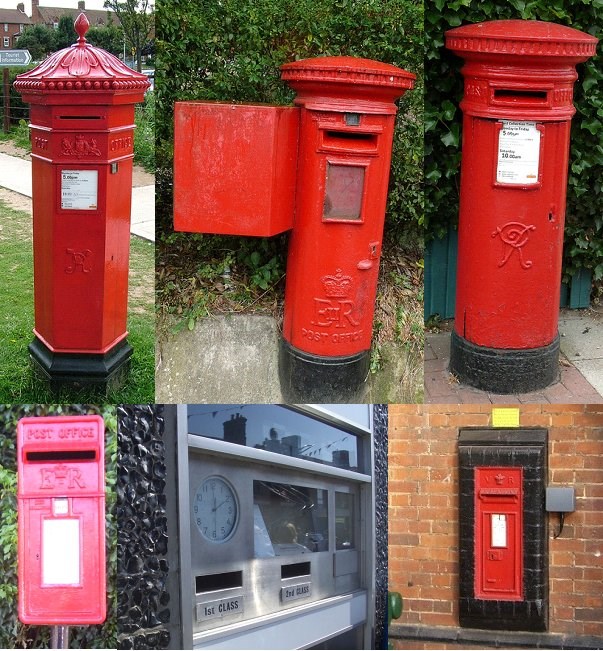Pat and Jess Multi-cache
-
Difficulty:
-

-
Terrain:
-

Size:  (micro)
(micro)
Please note Use of geocaching.com services is subject to the terms and conditions
in our disclaimer.
This cache will take you to seven different post boxes in Sheringham (although the information can also be found with a bit of research). The given coordinates will take you to the locaction for the first question. You need to look closely at the collection plate on each of the boxes. As well as the collection times there is also a unique number for each box and it is this number that you will need to make a note of.

Before the introduction of pillar boxes, on the UK mainland, it was customary to take outgoing mail to the nearest letter receiving house or post office. Such houses were usually coaching inns or turnpike houses where the Royal Mail coach would stop to pick up and set down mails and passengers. People took their letters, in person, to the receiver, or postmaster, purchased a stamp (after 1840) and handed over the letter.
The very first boxes erected on the mainland are not recorded, but the designs varied from area to area as each District Surveyor issued their own specifications and tendered to their own chosen foundries. The earliest ones were essentially experimental, including octagonal pillars or fluted columns, vertical slits instead of horizontal ones, and other unusual features. The boxes have been in use since 1852, just twelve years after the introduction of the first adhesive postage stamps and uniform penny post.
Prior to 1859 there was no standard colour; although there is evidence that the lettering and Royal Cypher were sometimes picked out in gold. In 1859, a bronze green colour became standard until 1874. Initially it was thought that the green colour would be unobtrusive. Too unobtrusive, as it turned out — people kept walking into them. Red became the standard colour in 1874, although ten more years elapsed before every box in the UK had been repainted.
The first real standard design came in 1859 with the First National Standard box. These were also cast in two sizes for the first time to allow for heavier usage in big metropolitan areas. The most famous of the early designs is that named after the architect who designed it, John Penfold. The Penfold boxes come in three sizes and altogether there are nine different types.
A return to cylindrical boxes followed with the so-called Anonymous boxes of 1879. Andrew Handyside of Derby was the foundry, but omitted the Royal Cipher and the words "Post Office" leading to the Anonymous soubriquet.. It took 13 years before this change was reversed, even though the box had undergone a major design change during that time.
New post box designs were ordered in 1887 for the Golden Jubilee of Queen Victoria. For the first time there was a lamp-post mounted letter box for use in London squares, but which soon established themselves in rural areas.
The Edward VII boxes had the posting aperture as part of the door, rather than the body of the box. That eliminated the chance for mail to get caught up in the top of the box. This basic design remains the same today, having served well throughout the reigns of George V, Edward VIII, George VI and Elizabeth II.
There are more than 150 recognised designs and varieties of pillar boxes and wall boxes, not all of which have known surviving examples. Royal Mail estimates there are over 100,000 post boxes in the United Kingdom.
In order to find the cache you need to visit the following locations or you can use an alternative means to obtain this information. The cache is about half the size of a film cannister. These locations are in the residential part of the town - the positioning of post boxes ensured that those wishing to use them didn't have far to walk.
N52° 56.400 E001° 12.529 NR26 260D
N52° 56.494 E001° 12.576 NR26 262F
N52° 56.486 E001° 12.262 NR26 261G
N52° 56.681 E001° 12.399 NR26 261E
N52° 56.564 E001° 12.298 NR26 261A
N52° 56.406 E001° 12.939 NR26 260B
N52° 56.274 E001° 12.995 NR26 261C
The cache can be found at: N52° 56.A(B+E)C E001° 12.DE(F-G)
If you need confirmation that the coordinates you have worked out are correct please email me via my user name.
In memory of our 'black and white' cat, Ellie.
Additional Hints
(Decrypt)
Lbh'ir nyernql qbar gur uneq jbex!